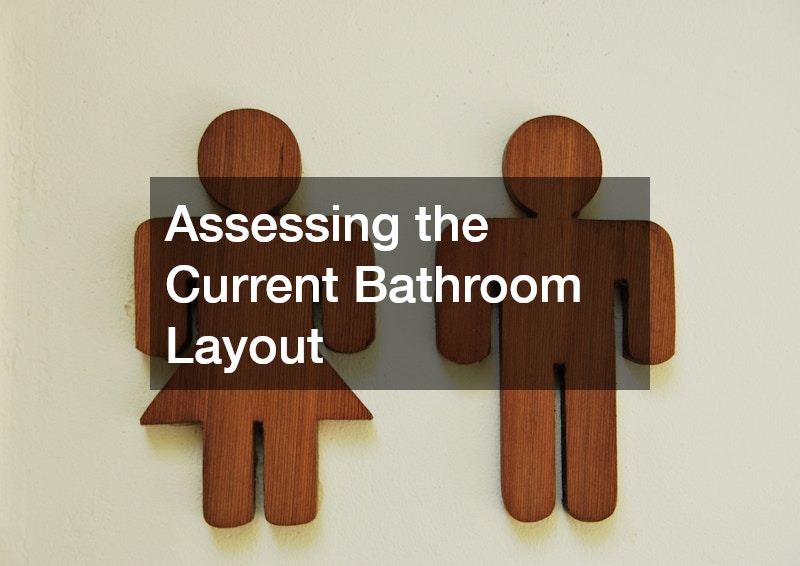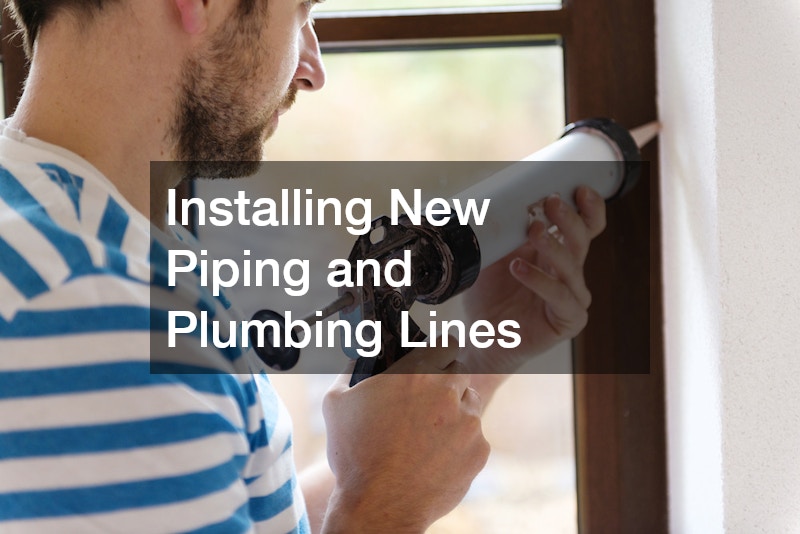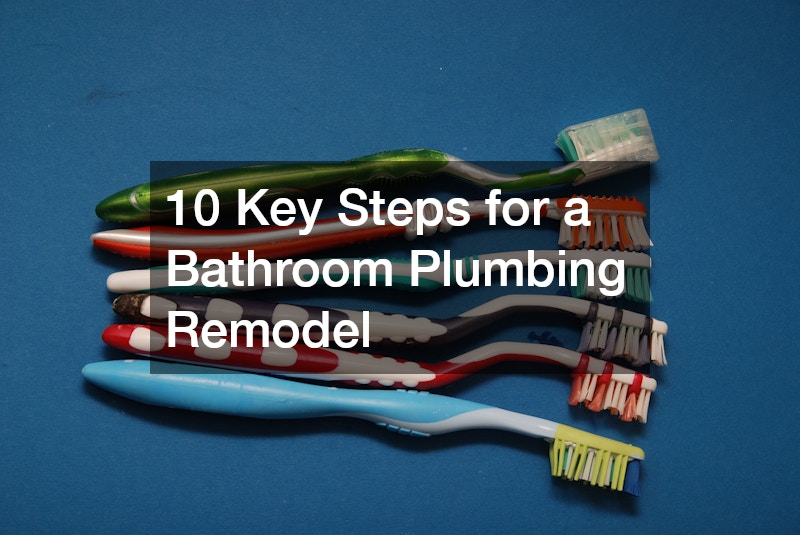Planning Your Bathroom Remodel
Undertaking a bathroom plumbing remodel can be a transformative project for any home, both in terms of aesthetics and functionality. The process involves more than just replacing fixtures or updating the design. It often requires a comprehensive evaluation of the existing plumbing system to ensure everything works properly, while also preparing for future upgrades. Whether you’re modernizing an outdated bathroom or expanding its functionality, careful planning is crucial to avoid common mistakes. From assessing your current bathroom layout to ensuring compliance with local building codes, each step in the remodeling process plays a pivotal role in the project’s success.

1. Assessing the Current Bathroom Layout
The first step in any successful bathroom plumbing remodel is assessing the current layout. Before making any significant changes, it’s essential to understand the existing plumbing infrastructure and how it fits into the overall design of the bathroom. This includes evaluating the positions of major fixtures like the toilet, sink, and bathtub, as well as the location of water lines and drainage systems. By analyzing the space and identifying potential limitations, homeowners can determine what adjustments are necessary to meet their goals, whether it’s adding new fixtures, upgrading existing ones, or reconfiguring the entire layout. A thorough assessment ensures that any proposed changes align with the technical requirements of plumbing and the practical needs of the household.
Specifically, when conducting this assessment, it’s also crucial to consider how the bathroom plumbing remodel will interact with other systems in the home. For example, if the project involves relocating fixtures, it may require extensive adjustments to the plumbing lines, which can increase both time and costs. This is where professional guidance becomes invaluable.
2. Determining Plumbing Needs and Upgrades
Once the current layout has been thoroughly assessed, the next key step in a bathroom plumbing remodel is determining the plumbing needs and potential upgrades. This phase is crucial for identifying areas where improvements can be made to the plumbing system, such as installing more efficient fixtures or upgrading outdated pipes. It’s also an opportunity to evaluate whether additional features, like water filtration systems or improved drainage solutions, would enhance the overall functionality of the bathroom. Understanding these needs helps homeowners make informed decisions about which aspects of the plumbing to prioritize during the remodel.
In more specific terms, this step often involves reviewing the existing pipes and connections to ensure they are in good condition. If there are signs of wear, corrosion, or outdated materials, it may be necessary to replace or upgrade them. Additionally, considering modern plumbing services such as installing low-flow fixtures or energy-efficient water heaters can greatly improve the efficiency of the bathroom.

3. Establishing a Budget for the Remodel
A bathroom plumbing remodel can vary greatly in cost depending on the scope of the project, making it essential to establish a clear budget early in the process. Setting a budget helps homeowners prioritize what is most important and allocate funds accordingly. Whether the focus is on upgrading plumbing systems, adding luxury features, or redesigning the entire layout, having a well-planned budget prevents overspending and ensures the project stays on track. It’s important to factor in both expected expenses, such as materials and labor, as well as unforeseen costs that may arise due to complications during the remodel.
On a more specific level, creating a budget for the remodel means breaking down individual costs, such as bathtub renovation services, plumbing fixture replacements, and installation fees. Homeowners should also consider the costs of permits, inspections, and potential upgrades to meet building code requirements. By thoroughly researching these expenses and working closely with contractors to get accurate estimates, it’s possible to create a realistic budget that covers all aspects of the remodel.
4. Choosing the Right Plumbing Fixtures
Selecting the right plumbing fixtures is one of the most exciting and crucial aspects of a bathroom plumbing remodel. Fixtures such as sinks, faucets, toilets, and showers not only impact the functionality of the space but also contribute to its overall aesthetic. When choosing fixtures, homeowners should consider both style and durability. It’s important to select products that are not only visually appealing but also efficient and built to last. High-quality fixtures can significantly enhance water usage efficiency, reduce maintenance issues, and improve the overall experience of using the bathroom.
More specifically, homeowners should focus on choosing fixtures that suit their specific needs and fit within the design of the remodel. For example, custom bathroom cabinets can complement the chosen fixtures while maximizing storage and enhancing the room’s organization. In addition, opting for water-saving technologies, such as low-flow showerheads or dual-flush toilets, can reduce water consumption and align with the sustainability goals of the bathroom plumbing remodel.

5. Hiring a Professional Plumbing Contractor
Hiring a professional plumbing contractor is a key step in ensuring the success of a bathroom plumbing remodel. While some homeowners may be tempted to tackle certain tasks themselves, remodeling a bathroom’s plumbing system requires specialized knowledge and skills. A licensed contractor has the expertise to handle complex installations, ensure everything is up to code, and prevent costly mistakes. They can also provide valuable guidance on selecting materials, troubleshooting unexpected issues, and managing the project efficiently from start to finish. Trusting a professional with the plumbing aspect of the remodel allows homeowners to focus on other design elements without worrying about technical challenges.
In more specific terms, choosing the right contractor often involves researching local professionals and comparing services. Homeowners should seek out contractors with experience with bathroom remodeling services, particularly those offering drain cleaning service and other essential plumbing tasks. Additionally, verifying that the contractor is properly licensed and insured protects against liabilities and ensures that the work meets safety standards. Hiring a qualified contractor guarantees that the bathroom plumbing remodel will be executed professionally, reducing the likelihood of future plumbing issues or complications.
6. Planning for Drainage and Ventilation
An essential part of any bathroom plumbing remodel is ensuring that the drainage and ventilation systems are adequately planned. Proper drainage is critical for preventing water buildup, which can lead to leaks, mold, and long-term structural damage. Equally important is proper ventilation, as bathrooms tend to accumulate moisture, which can cause deterioration over time. When planning these systems, homeowners must consider the current state of the bathroom’s drainage and whether upgrades are necessary to accommodate the new layout or fixtures. Ventilation systems, such as exhaust fans, should also be evaluated to ensure they are strong enough to remove excess moisture effectively.
More specifically, addressing drainage concerns may involve storm drain cleaning or improving the slope of the floor to direct water flow efficiently. Homeowners should also verify that all plumbing components, such as pipes and drains, are in good condition and free from blockages. In some cases, adding or replacing ventilation systems may be necessary to ensure that humidity levels are controlled, reducing the risk of mold growth.

7. Installing New Piping and Plumbing Lines
As part of a bathroom plumbing remodel, installing new piping and plumbing lines can be a significant yet necessary step. Whether the goal is to expand the bathroom’s capacity or replace outdated pipes, upgrading the plumbing infrastructure is often essential for ensuring efficiency and compliance with modern standards. This step may involve rerouting pipes to accommodate new fixtures, installing additional water lines for enhanced water pressure, or replacing old pipes with more durable materials like copper or PEX. Proper installation ensures that water flow remains consistent throughout the remodel and that the plumbing system can handle the demands of the updated bathroom.
On a more specific level, this phase of the remodel may require professional water repair service, especially if the existing plumbing has sustained damage or is inefficient. Homeowners may also need to assess whether current water lines are adequate for new fixtures, such as high-flow showers or multiple sinks. Any necessary repairs or upgrades should be addressed before proceeding with cosmetic changes. By installing new piping and plumbing lines during the bathroom plumbing remodel, homeowners can avoid future complications and ensure a high-performing, reliable plumbing system.
8. Ensuring Compliance with Building Codes
A crucial aspect of any bathroom plumbing remodel is ensuring that all changes comply with local building codes and regulations. These codes are in place to protect the safety and health of the occupants by establishing standards for plumbing, electrical work, and structural integrity. Homeowners must be aware of the specific requirements for their area, as failing to adhere to these regulations can lead to fines, delays, or even the need to redo parts of the remodel. Working with professionals who understand these codes is the best way to ensure compliance, as they are equipped to navigate the complexities of permits, inspections, and legal requirements.
More specifically, one of the most common upgrades during a remodel is a water heater replacement, which often requires adherence to specific safety standards regarding ventilation, pressure, and placement. Homeowners must ensure that their water heating systems meet these regulations to avoid safety hazards and ensure proper operation. Verifying that all aspects of the remodel comply with building codes not only safeguards the homeowner’s investment but also provides peace of mind that the bathroom plumbing remodel is being completed safely and legally.
9. Testing the System for Leaks and Functionality
After the installation of new plumbing lines and fixtures, the next critical step in a bathroom plumbing remodel is thoroughly testing the system for leaks and ensuring its functionality. Proper testing is essential to catch any issues before finalizing the remodel, as undetected leaks can lead to water damage, mold growth, and even structural damage over time. Homeowners and contractors should test each component, including sinks, showers, toilets, and bathtubs, by running water through them and inspecting the pipes for any signs of leaking or reduced water pressure. This phase also includes ensuring that all fixtures function as expected and that there are no blockages or drainage problems.
On a more specific level, using advanced techniques like water jet cutting service can help in clearing out any stubborn blockages that may affect the plumbing system’s efficiency. By thoroughly testing the entire system, homeowners can be confident that the new plumbing is working optimally and will provide long-lasting performance. It’s crucial to resolve any issues at this stage to avoid more costly repairs down the line, ensuring that the bathroom plumbing remodel is completed to the highest standards.
10. Finalizing the Remodel and Clean-Up Process
The final stage of a bathroom plumbing remodel is the completion of any remaining tasks and a thorough clean-up of the work area. This phase includes making sure all fixtures are properly sealed, all connections are secure, and any construction debris is cleared from the site. Final inspections should be conducted to ensure that everything meets safety and aesthetic standards, and any touch-ups or final adjustments should be completed before the remodel is considered finished. This step marks the transition from a construction zone to a fully functional and refreshed bathroom space.
Specifically, this stage often includes a final septic system inspection to verify that the plumbing system, especially the drainage, is working efficiently and that there are no leaks or blockages. Cleaning up any leftover construction materials and ensuring that the area is spotless is crucial for giving the homeowner a clean, ready-to-use bathroom. This finalization process wraps up the bathroom plumbing remodel, leaving the homeowner with a beautifully upgraded bathroom that functions flawlessly for years to come.
Maintaining New Bathroom Health
A successful bathroom plumbing remodel involves several key steps that must be carefully planned and executed to ensure a functional and aesthetically pleasing outcome. From assessing the current layout to ensuring compliance with building codes and finalizing the installation, each phase plays an important role in transforming the bathroom into a modern and efficient space. Along the way, it’s essential to consider factors such as drainage, ventilation, fixture selection, and the integrity of the plumbing system to avoid common pitfalls. By addressing these critical elements, homeowners can create a bathroom that not only meets their design preferences but also functions seamlessly for years to come.
